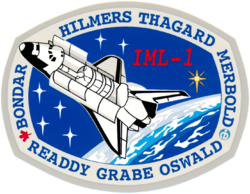William F. Readdy
| William Francis Readdy | |
 | |
| NASA-Astronaut | |
|---|---|
| Född | 24 januari 1952 Rhode Island |
| Tid i rymden | 28 dagar, 44 minuter |
| Urvalsgrupp | Astronautgrupp 12 |
| Uppdrag | STS‑42, STS‑51, STS‑79 |
| Uppdragsemblem | |
William F. Readdy, född 24 januari 1952, är en amerikansk astronaut uttagen i astronautgrupp 12 den 5 juni 1987.
Rymdfärder
Källor
”Biographical Data” (på engelska) (PDF). NASA. januari 2006. https://www.nasa.gov/wp-content/uploads/2016/01/readdy_william.pdf?emrc=b34fe2. Läst 13 augusti 2024.
Media som används på denna webbplats
STS-79 was the fourth in a series of NASA docking missions to the Russian Mir Space Station, leading up to the construction and operation of the International Space Station (ISS). As the first flight of the Spacehab Double Module, STS-79 encompassed research, test and evaluation of ISS, as well as logistics resupply for the Mir Space Station. STS-79 was also the first NASA-Mir American crew member exchange mission, with John E. Blaha (NASA-Mir-3) replacing Shannon W. Lucid (NASA-Mir-2) aboard the Mir Space Station. The lettering of their names either up or down denotes transport up to the Mir Space Station or return to Earth on STS-79. The patch is in the shape of the Space Shuttle's airlock hatch, symbolizing the gateway to international cooperation in space. The patch illustrates the historic cooperation between the United States and Russia in space. With the flags of Russia and the United States as a backdrop, the handshake of Extravehicular Mobility Unit (EMU) which are suited crew members symbolizes mission teamwork, not only of the crew members but also the teamwork between both countries space personnel in science, engineering, medicine and logistics.
NASA astronaut William F. Readdy
STS-42 Mission Insignia
Emblem of Nasa's STS-51 mission.




